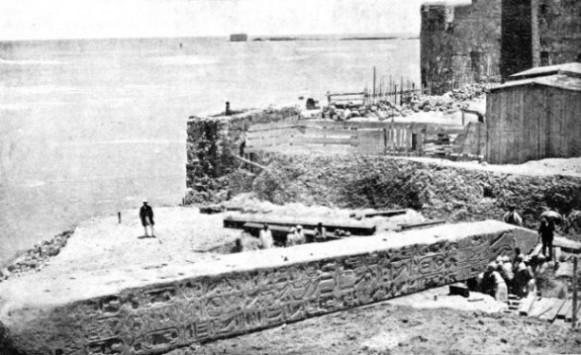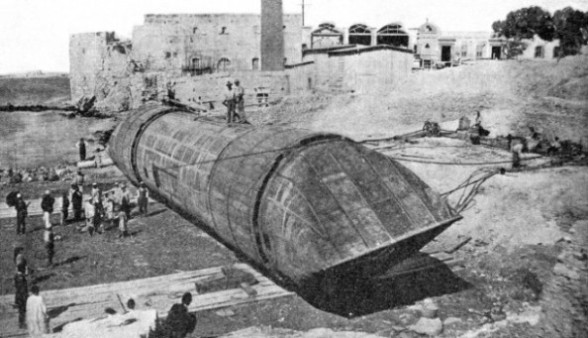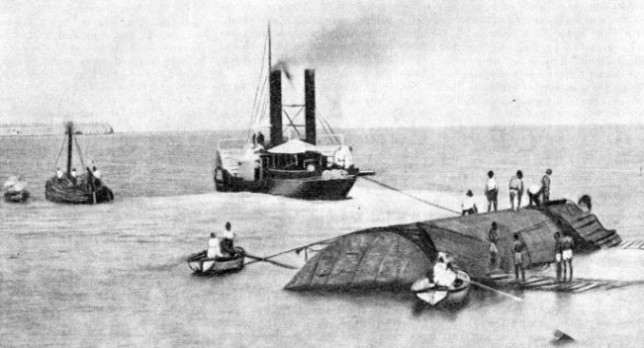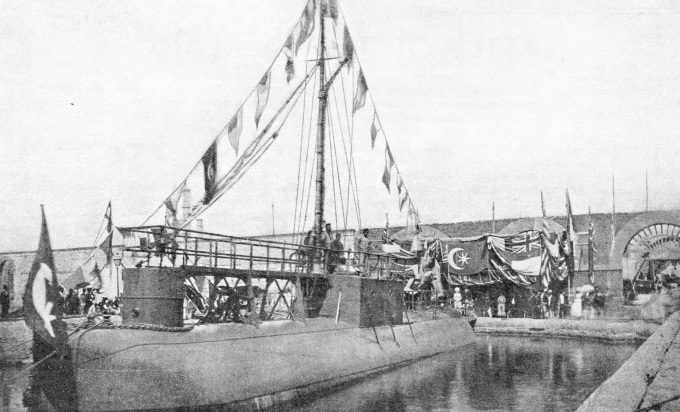

© Shipping Wonders of the World 2012-

The Voyage of the “Cleopatra”
That familiar London landmark, Cleopatra’s Needle, now on the Victoria Embankment, was towed from Egypt in a vessel, the “Cleopatra”, which had been specially built round the obelisk. After abandonment in tragic circumstances during a storm in the Bay of Biscay, the “Cleopatra” safely reached Gravesend, Kent, on January 21, 1878
IN DOCK AT ALEXANDRIA ready for the voyage to England. The Cleopatra, containing the obelisk, was fitted out as a sea-
LONDONERS are so familiar with Cleopatra’s Needle on the Victoria Embankment that they scarcely turn their heads to look at it. Sometimes the careless passer-
Though the sadly blackened surface of the obelisk belies the fact, it is composed of a single block of syenite, that famous rose-
Another important thing is that the obelisk was not built by Queen Cleopatra. The queen is said to have offered it as a gift to Octavian, who later became the Emperor Augustus. The workmen of Augustus removed the obelisk from On, or Heliopolis, the City of the Sun, where it had stood since its erection, about 1500 B.C., by King Thothmes III. Augustus attempted to remove it to Europe in 23 B.C. but, though the Romans succeeded in transporting other Egyptian monoliths to their own country, this one baffled them for some reason, and it remained lying in the sand at Alexandria for another eighteen centuries.
In 1801, Sir Ralph Abercrombie acquired the Needle on behalf of the British people, but he, in the same way as Augustus so many hundreds of years before, was unable to move it from its sandy bed at Alexandria, so near and yet so far from the tideless shores of the Mediterranean. So its new and rather useless British ownership lapsed in the course of years. Twice, during the nineteenth century, offers to the British Government were made by Egypt, the second time by the Khedive, on March 15, 1877.
Meanwhile interest in the Needle had not been lost. In 1868, in a paper read before the Royal Society in Edinburgh, General Sir James Alexander said how he had made himself acquainted with the Engineer of the Clyde Navigation, Mr. A. Duncan. “I went over the matter with him of the means of transporting the obelisk, and I suggested an iron casing or vessel built round it.”
Sir James was on the right track with his ideas for an iron casing, but some odd alternatives were being suggested at the time. One of these was that a canal should be cut from the sea to that point in the sands where the Needle lay, that the Needle should be made to float by lashing to it a considerable quantity of timber, when it would be possible to tow it out to the sea. Apart from its crudity, a weak point of this idea was that Egypt contains no timber worth mentioning.
The transport contractors of the ancient Roman Empire had dealt with obelisks and similar great monoliths by packing them in corn or lentils in the holds of their biggest merchantmen. Once this was done, the transport was an easy matter. The greatest trouble and expense was entailed by the preliminary jacking up and lifting of the monuments, for this had to be accomplished entirely by manual power. It required unlimited patience and an advanced knowledge of physics and mechanics, all too rare qualities in the days of the Caesars.
The Khedive’s offer of 1877 was promptly followed by another, that of Mr. James Erasmus Wilson, who undertook to pay all expenses incurred by the transport of the obelisk from Alexandria to London. For this generosity he was knighted in 1881. Erasmus Wilson got into touch with John Dixon the engineer, who was confident that he could build a cylindrical ship round the Needle where it lay, roll it down to the sea, and tow it home with a steam tug. His brother Wainman Dixon was to assist him in the building of this cylindrical vessel. Mr. Benjamin Baker, one of the engineers of the original London Underground Railway, who was yet to achieve further greatness and a knighthood as co-
So the Dixons set to work to build their oddly-
Thirty Tons of Ballast
A number of lesser relics had already disappeared suddenly, under cover of darkness, and pieces of them had gone to the building of cheap houses and the provision of roadmaking materials.
First of all, the great monolith had to be jacked up, so that there was space beneath it in which to lay the keel of the vessel and build up her bottom plating. Inch by inch it was raised above the surface of the sand until it occupied rather more than the elevation at which it would lie inside the ship. Once this had been done, the going was easier, and within a surprisingly short time the obelisk was hidden in the shell of the nascent vessel as a chrysalis lies inside a cocoon.
The shell was of wrought iron plates, and took the form of a cylindrical chamber 92 feet long and 15 feet in diameter. At bows and stern the cylinder tapered to a blunt, wedge-

INCH BY INCH the great monolith, weighing 186 tons, was jacked up, so that there was a space underneath it in which to lay the keel of the Cleopatra. The obelisk is made of a single block of syenite. It is 68 ft. 5½ in. high and measures 7 ft. 10½ in. by 7 ft. 5 in. at its rectangular base.
So Cleopatra’s Needle vanished from its sunny bed on the sands into its narrow iron prison, and was seen no more by the eyes of Egypt. The cylinder was carefully sounded and tested to make doubly sure that it was watertight, and then rolled gently away across the sand, down the shore and into the sea. Through the shallow water it rolled, until it was floating on an even keel in deep water. Thus was launched the good ship Cleopatra.
The Dixons’ task, however, was not yet finished, for it was not intended to tow the Cleopatra, unmanned, as if she were a mere giant log of wood. As with more orthodox vessels, much remained to be done before she was completed and seaworthy. On what had now become the upper side of the cylinder there was presently built a narrow deckhouse, containing cabins for the captain and crew who were to travel in her.
Forward of this rose a small cylindrical column, designed to serve the double purpose of acting as a cutwater and supporting the forepart of the small hurricane deck which ran aft over the top of the deckhouse. Steering gear was also installed, with a wheel on the hurricane deck, and a mast was erected and rigged with a small sail to assist the helmsman. Motive power was to be left entirely to the accompanying vessel, a Johnson Line cargo steamer of 1,329 tons gross.
The Cleopatra was about the oddest-
A Difficult and Dangerous Tow
On September 21, 1877, the Cleopatra left Alexandria with a crew of eight Maltese sailors under the command of Captain Carter. She was towed by the Olga, a schooner-
Slowly and steadily the Olga steamed up the length of the Mediterranean with her strange charge in tow. Fortune favoured the anxious voyagers, for the Mediterranean was as smooth as that great tideless sea can be. Cautiously they slipped past the island of Sicily. Malta came and was left behind. The great Rock of Gibraltar loomed up over the horizon and became bigger and bigger as the Straits were approached. Still the sea resembled a vast lake under smiling summer skies.
This was too good to last, however. The two vessels rounded Cape St. Vincent and were headed up the Portuguese coast. The promise of fair weather was less evident by now, but bad times held off until the vessels were off Cape Finisterre, on the evening of October 13. The wind showed signs of changing from a southerly to a westerly quarter, and the barometer began to drop, steadily and ominously. The wind blew up and the seas began to get choppy. By next morning the Olga and the Cleopatra were well into the Bay of Biscay in the teeth of a squall.

REPAIRING THE CYLINDER after the launch, when a rock damaged the plating. At either end the cylinder tapered to a blunt, wedge-
Every fresh sea broke right over the clumsy bows of the Cleopatra, but under this test, for the first time, certain features of the little vessel’s design began to show their quality. The cylindrical column under the forepart of the hurricane deck “split each wave and, throwing the halves on each side, left, the deckhouse clear.” Under the ordeal by storm — the squall was rapidly working itself up into a Biscayan hurricane of no mean power — the pitching of the Cleopatra became extremely bad because of the necessarily uneven distribution of weight caused by the tapering form of the Needle.
The rolling, however, was at first negligible, as the cylindrical hull of the Cleopatra presented a sort of one-
In the face of such conditions, Captain Carter took the only course possible. He ordered the vessel to be hove-
Captain Carter had to make another quick decision. He ordered the Olga to cast off. In her present unenviable position the Cleopatra would be unable to make any signals by flare when darkness fell, and that was rapidly taking place. She would not be able to show any lights at all, and it was gravely feared that the weight of 400 yards of 3½-
Tragedy in the Night
The risk was considered to be entirely that of the Olga, as the constructional features of the Cleopatra included a collision chamber, or watertight compartment, in her nose. But that same blunt-
Efforts were still being made to right the Cleopatra. Her mast was cut away and cast overboard. With it went the useless sail and rigging. But no improvement became evident. No amount of clearing her superstructure could possibly right her shifted ballast, and so there she lay in the heaving waters, with her deck tilted at a drunken angle of 50 degrees. It was decided then that the only course for Captain Carter and his crew was to abandon ship.
Then came the tragedy. Captain Booth of the Olga sent out six men in one of the steamer’s boats to try to rescue Carter and his crew. This boat crossed the heaving space between and drew close alongside the Cleopatra. A rope was thrown and caught. The next instant another huge sea broke. The Olga’s boat, with all in her, was snatched away from the side of the Cleopatra and lost in the crashing wilderness of waters. Neither the boat nor those who manned her were ever seen again.
Nothing could be done in the blustering wet darkness, for night had now fallen. Somehow the two vessels managed to remain within hail of each other and, when dawn broke, the Olga made a second attempt to rescue the company of the Cleopatra. By now, the storm had considerably abated overhead, though the sun was not yet risen.

ENCASED IN THE CYLINDER, Cleopatra’s Needle was rolled down into the sea. To make the cylinder self-
High, racing clouds scudded across a rapidly clearing sky, but the seas were still running high and there was little enough hope in the clearing of the heavens, at least for the time being. The Olga started paying out a length of Manila rope, which, being light, floated easily on the surface of the waters. She then steamed across the bows of the Cleopatra and allowed the rope to strike against her stem. The seas, however, washed it away in a moment, before anyone in the Cleopatra could catch it and make it fast.
There was nothing for it now but to make a dangerous manoeuvre, namely, for the Olga to steam close in upon the Cleopatra and to cast a rope on board her. This was done without accident. The rope was caught and made fast. A hawser was then bent on this line, and this the Cleopatra’s men secured to the forepart of the heaving vessel. By this time the Olga had drawn off to a safe distance again, paying out the hawser as she went. One of her boats was then hauled across empty by the rope and came safely alongside the Cleopatra.
Somehow Captain Carter got all his men into the little tossing boat of the Olga, which was drawn back to her mother ship. The order was given to cut the Cleopatra adrift. Rapidly the queer-
Thus the Cleopatra might have remained, lost and tossed about in the same way as a load of waterlogged timber until some large steamer ran her down in the darkness of night. But, as it happened, the steamer which came to cross her path turned up, not in the night, but in broad daylight, shortly after her loss. This was the British cargo vessel Fitzmaurice, bound for Valencia, Spain. The lookout of the Fitzmaurice reported an odd-
The Final Voyage
The next thing was how the Cleopatra was to make the last stage of her journey, when she had been duly repaired and rendered seaworthy again. John Dixon chartered the tug Anglia, the largest in the Port of London. She was a fine sea-
Early in the morning of January 16, 1878, she took the rescued Cleopatra in tow. The Cleopatra tended to draw right level with the tug, with the towing hawser at right angles between them. The harbour was cleared an hour after anchor had been weighed and the Anglia shaped her course for Ushant. The steering of the Cleopatra then improved noticeably, possibly with the increase of experience in handling her on the part of the Anglia. The improvement was, however, not entirely constant, and at intervals all the way home the eccentric little vessel did the most peculiar things.
Ushant Light was sighted at 9.50 p.m. on January 17, and Ushant was rounded a few hours later. Both little vessels bore bravely up the English Channel. Anchor was dropped for the first time in British waters off the Chapman Light, at 10.30 p.m. on January 20. By 10.0 a.m. on the following morning, the two vessels were lying off Gravesend, and the adventurous voyage of the Cleopatra was all but finished. At sea, the Anglia’s hawser which towed the Cleopatra had been 600 feet long, but for the passage up the Thames this was shortened to 90 feet.
So the Cleopatra was brought slowly up river into the heart of London, to be a centre for admiring crowds before she delivered her precious cargo and was broken up.

THE SUCCESSFUL LAUNCH of the cylindrical ship containing the obelisk. Cleopatra’s Needle, set up about 1500 B.C. at Heliopolis, Egypt, was moved in the first century B.C. to Alexandria, where it remained lying in the sand for centuries. In 1801 Great Britain acquired the obelisk. In 1877 it was encased, where it lay, in a shell of wrought iron plates. The length of the casing was 92 feet and its diameter 15 feet When complete the vessel was rolled gently down the shore into the sea.
You can read more on “Battle of the Nile”, “Dramas of Salvage” and “The Suez Canal” on this website.
